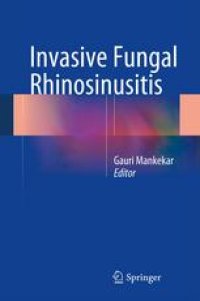
Ebook: Invasive Fungal Rhinosinusitis
- Tags: Otorhinolaryngology, Infectious Diseases, Internal Medicine, Head and Neck Surgery
- Year: 2014
- Publisher: Springer India
- Edition: 1
- Language: English
- pdf
Incidence of invasive fungal sinusitis has been increasing over the years. The understanding of its pathophysiology has improved with newer serological tests and diagnostic methods helping in earlier diagnosis and reducing patient morbidity. It was believed earlier that invasive fungal sinusitis is seen only in immune compromised patients but clinical reports suggest otherwise. More anti-fungal drugs are being added to improve incidence of patient survival. This book aims to compile all practical information about invasive fungal sinusitis into a single volume. Therefore, busy clinicians would not have to perform exhaustive literature studies to diagnose invasive fungal sinusitis. The book aims to provide an overview of diseases which could be mistaken for invasive fungal sinusitis and discuss how the management is different.
Book sections consist of clinical, microbiological, serological, pathological, radiological and pharmacological features of the disease and its management. Each section is important in today’s context as it dynamically alters the management of the patient. Early clinical suspicion and rapid microbiological, pathological and radiological diagnosis with aggressive treatment with surgical debridement and medical therapy leads to favorable outcomes.
Incidence of invasive fungal sinusitis has been increasing over the years. The understanding of its pathophysiology has improved with newer serological tests and diagnostic methods helping in earlier diagnosis and reducing patient morbidity. It was believed earlier that invasive fungal sinusitis is seen only in immune compromised patients but clinical reports suggest otherwise. More anti-fungal drugs are being added to improve incidence of patient survival. This book aims to compile all practical information about invasive fungal sinusitis into a single volume. Therefore, busy clinicians would not have to perform exhaustive literature studies to diagnose invasive fungal sinusitis. The book aims to provide an overview of diseases which could be mistaken for invasive fungal sinusitis and discuss how the management is different.
Book sections consist of clinical, microbiological, serological, pathological, radiological and pharmacological features of the disease and its management. Each section is important in today’s context as it dynamically alters the management of the patient. Early clinical suspicion and rapid microbiological, pathological and radiological diagnosis with aggressive treatment with surgical debridement and medical therapy leads to favorable outcomes.